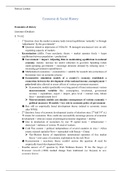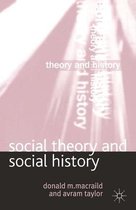Patricia Leistner
Economic & Social History
Economics & history
Literature (Drukker)
P. 79-102
- 1st Question: does the market economy tends toward equilibrium ‘naturally’ or through
‘adjustments’ by the government?
Question related to depression of 1920s/30 damaged neoclassical view on self-
regulating capacity of markets
- Keynesianism (differ. From neoclassic theory = market operates freely + keeps
equilibrium between population + production)
Government = import. Adjusting Role in maintaining equilibrium in national
economy, namely: increase tax and/or reduction in governm. Spending (when
under-spending government = encourage domestic demand by reducing taxes +
increasing government expenditures)
Mathematical economics + econometrics = suitable for research into correctness of
Keynesian view on economic process
Econometric simulation models of a country’s economy established a
connection between the development of the national income, unemployment +
price level (also allowed to assess effects of various government measures
Econometric models (preferably over long period of time) interconnect various
macroeconomic variables like: consumption, investment, government
revenue + expenditure, export + import, price level + interest rates, labour
force + unemployment level
Macroeconomic models can simulate consequences of various economic +
political measures models = key role in economic policy of government
But: still no empirically based development theory (related to economic issues
after WWII)
- 2 Question: Issue of economic development (centre of attention since 2 nd half 19th ct.)
nd
means for economics: How could one successfully encourage process of economic
development + what are causes of prolonged economic stagnation + decline
Due to destruction of economies by war capital stock + infrastructure =
destroyed + millions of victims need of workers
Cold War context + political independence of several countries in Asia + Africa
(many rejected capitalist West + reproached with Russia + China)
Neo-Marxist theory of imperialism: unrestrained operation of free market
forces = root cause of economic exploitation by the rich West
Keynesianism + neoclassic theory couldn’t answer this question need for
empirically based development theory
- Possible answer of 2nd question by Walt Withman Rostow his The Stages of
Economic Growth (1960) marked change from traditional (i.e. Keynes) to new
economic history
,Patricia Leistner
Revised tradition of historical school (phase theories in analysing economic
development processes reflecting typical characteristics of cert. phases)
Rostow: 5 stages of economic development necessary to become modern,
prosperous economy: Traditional society (1), Pre-conditions for take-off (2),
Take off (3), Drive to maturity (4), Age of high mass-consumption (5)
Historical school failed to specify conditions in which one phase passed into
another main condition: transition = formed by sudden increase in ratio of
investment to national income acceleration of growth of capital stock
increase in labour productivity
Problem with Rostow’s theory: stages don’t work out when they are shuffled or
applied to countries where development differed from that of the UK or US
- New economic history (still looking for answer to Question 2)
Aimed at long-term explanation of phenomenon of economic growth (mainly in
mathematical form), ex: Cobb + Douglas + their production function (pf)
Pf = mathematical equation relating the output of an economic system (annual
production of country) to inputs (quantities of production factors: labour, land,
capital) on this basis growth theories developed
Problem: empirical testing of hypothesis derived from theory in complex
mathematical form
But: development of econometric models = essential analytical instrument for
economic policy of central government (1960s, in western countries) relation
macroeconomic variables (i.e. consumption, investment)
Resulted into quantitative reconstruction of economic development in 20th ct.
allowed to move further back in time, i.e. global economic situation 2nd half 18th ct.
New economists = trained in mathematical economics + econometrics =
methodological revolution within economic history successfully applied to
multiplicity of history issues
- Breakthrough: Conrad + Meyer’s “The Economics of Slavery” (1958), Question:
production of cotton by means of slave labour after Civil War = profitable?
Southern Americans perceived it as profitable while North was against it
Previous views agreed upon that it is unprofitable (attention: topic is highly
emotionally + morally charged) due to declining cotton price since 1830s
Conrad + Meyer = new method of viewing problem solely from mathematical
economic + econometric angle consider slave as commodity (as other means of
production slaves have a lifespan, maintenance/ energy supply in form of food,
clothing, housing) thus: production of cotton through slave labour after Civil
War = highly profitable (other factor: slave families = many children high-
profit)
historians (importance of individual source) vs econometrics (application of
averages to estimate course of cert. development)
- The Breakthrough (2): Fogel’s Railroads (1964)
Scientific analysis of economic growth in US during last decades of 20th ct.
Contested idea that high growth rate of economy = caused by railroads
Traditional argument: rail transport caused reduction in transport costs thus
reduction in prices of agricultural + industrial products sharp increase in
sales
,Patricia Leistner
Fogel: economic growth = also evolved with absence of railroads thus: cheap
transportation (i.e. via canals) = necessary condition
Great expansion of iron industry (1845-1849) due to great demand for nails
(not use for rails)
Method: counterfactual analysis = imaginary counterexample (canals) to
determine impact of 1 specific factor on development of complex historical
process
Criticism: counterfactual analysis = not history not based on facts
argument can be countered by the fact traditional economic historians
introduce them implicit + not explicit (new economic historians), ex:
imagining a different turn out of a battle if one side would have used other
weapons or technique main point: counterargument needs to be a reasonable
alternative (ex: you can’t apply machine guns to a 15th ct. battle)
- For economic historians: properties of the system within facts are irrelated = centre of
research (not exact historical facts)
p. 140-147 – William Fogel + Stanley Engerman:
- Confirmed Conrad + Meyer regarding the profitability of slavery before 1860
- Showed that traditional image of economic situation in South America prior to Civil
War = mistaken (not North more prosperous but South + economic development =
more favourable in ‘traditional’ South than in ‘modernizing’ North)
Income per capita in South higher than in North South = not backward,
stagnating economy as previously expected
quantitative research (qr) helped to show that in North America + the Caribbean
the living conditions of slaves = worse than in South of US
qr provided assumption with facts
but: favourable material conditions of slaves in South = exception
- proved that living conditions of slaves in South = better than previously expected (i.e.
4000 kcal p. slave per day)
production of cotton = higher profits than manufacture of industrial products
- criticism (by others) of Fogel + Engerman: didn’t use random sample
only used records of large plantations whereas small plantations = more
characteristic of South
Lecture
Overview:
1. The relation between economics and history
2. Economic growth and welfare: rich and poor
3. Crises, business cycles and continuity
Economics and History
- Economic science
- Historical school’: ‘Methodenstreit’: description vs models (positivism)
- Traditional economic history
- Neoclassics, Keynesians, and econometrics
, Patricia Leistner
- New Economic History
- Historical national accounts: measuring GDP in the long run
Economic history comprises the history of (I):
- The economy of countries, provinces, regions, cities, and villages in specific periods.
- An organisation: Corporate history [VOC, Shell, Campina] or institutional history
[water boards, governmental departments Etc.]
- An industry [Banks, textile industry, agriculture]
- Technology (Dutch: Techniekgeschiedenis), i.e. the use of a windmill + its changes
over time
- Consumption [advertisement, food, cloths, use of cars]
Economic history consists out of the history of (II):
- (Economic) Governmental policies of a country, province or city [crisis policy,
environmental policy, policy on transport and infrastructure]
- A specific economic aspect (of a country, province, region, city, etc.) [credit, housing/
living, education]
- The economic behaviour of people at an individual level: Motives, choices, and
strategies [gender]
- Labour [tasks, working hours, labour conditions, wages]
- Standard-of-living, prosperity, and well-being
- Ex: pictures in presentation each reflect a different level of economy, i.e. the food
(meat) can reflect well-being, different dresses relate to question of place of
production + their price
Economics
Question: How - while having only limited (scarce) resources at disposal - to satisfy unlimited
needs and wants people have? people always want more of something (technology, food)
- What is produced? (textiles, food, etc)
- How is it produced? (by hand, animal power, by machines, in a factory)
- How is production divided among the population? (question of past + present
generations)
Ex: grain production of a farmer doesn’t keep all the produce for himself
How much goes to the rich people + how much to the poor?
All these questions are descriptive analytical question look for instance at why
there is an unequal distribution of food/ wealth, etc.
- Micro-level (people + their decisions; a specific market, i.e. grain market)/ Macro-
level (situation of the whole country, i.e. total of production, unemployment,
investment)
Economic method
- Descriptive, but above all explanatory
- Positivism: Objective knowledge is possible (method originating from natural
sciences)
- Try to find general laws (not interested in unique, (historical) individual cases)





